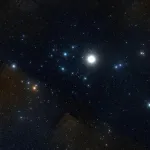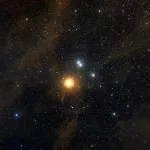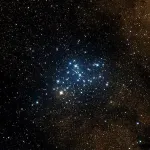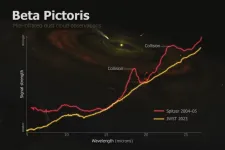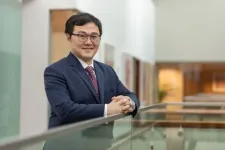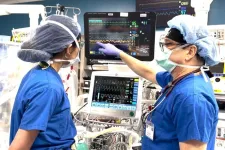(Press-News.org) An international team of astronomers led by the University of Vienna has deciphered the formation history of young star clusters, some of which we can see with the naked eye at night. The team, led by Cameren Swiggum and João Alves from the University of Vienna and Robert Benjamin from the University of Wisconsin-Whitewater, reports that most nearby young star clusters belong to only three families, which originate from very massive star-forming regions. This research also provides new insights into the effects of supernovae (violent explosions at the end of the life of very massive stars) on the formation of giant gas structures in galaxies like our Milky Way. The results were published in the renowned journal Nature.
"Young star clusters are excellent for exploring the history and structure of the Milky Way. By studying their movements in the past and thus their origin, we also gain important insights into the formation and evolution of our galaxy," says João Alves from the University of Vienna, co-author of the study. Using precise data from the European Space Agency's (ESA) Gaia mission and spectroscopic observations, the team traced the origins of 155 young star clusters within a radius of about 3,500 light-years around the Sun. Their analysis shows that these star clusters can be divided into three families with common origins and formation conditions. "This indicates that the young star clusters originate from only three very active and massive star-forming regions," says Alves. These three star families are named after their most prominent star clusters: Collinder 135 (Cr135), Messier 6 (M6), and Alpha Persei (αPer).
"These findings offer a clearer understanding of how young star clusters in our galactic neighborhood are interconnected, much like members of a family or ‘bloodlines’", says lead author Cameren Swiggum, a doctoral student at the University of Vienna. "By examining the 3D movements and past positions of these star clusters, we can identify their common origins and locate the regions in our galaxy where the first stars in these respective star clusters formed up to 40 million years ago."
These Massive Explosions Likely Also Created Our "Local Bubble"
The study found that over 200 supernova explosions must have occurred within these three star cluster families, releasing enormous amounts of energy into their surroundings. The authors concluded that this energy likely had a significant impact on the gas distribution in the local Milky Way. "This could explain the formation of a superbubble, a giant bubble of gas and dust with a diameter of 3,000 light-years around the Cr135 family," explains Swiggum. Our solar system is also embedded in such a bubble, the so-called Local Bubble, which is filled with very thin and hot gas. "The Local Bubble is probably also linked to the history of one of the three star cluster families," adds Swiggum. "And it has likely left traces on Earth, as suggested by measurements of iron isotopes (60Fe) in the Earth's crust."
"We can practically turn the sky into a time machine that allows us to trace the history of our home galaxy," says João Alves. "By deciphering the genealogy of star clusters, we also learn more about our own galactic ancestry." In the future, João Alves' team plans to investigate more precisely whether and how our solar system has interacted with interstellar matter in our home galaxy, the Milky Way.
This research was supported by the ERC Advanced Grant ISM-FLOW (Alves), the Austrian Research Promotion Agency (FFG), the German Research Foundation (DFG), and NASA.
Video
END
Galactic bloodlines: Many nearby star clusters originate from only three "families"
Supernova explosions from the formation history of these families also left traces on Earth
2024-06-10
ELSE PRESS RELEASES FROM THIS DATE:
New City of Hope study shows liver surgery to remove cancer can now be a safe, outpatient procedure
2024-06-10
LOS ANGELES — A new study guided by a renowned surgeon at City of Hope®, one of the largest cancer research and treatment organizations in the United States, demonstrates that robotic liver surgery can be a safe, outpatient procedure. In fact, 8% of the patients sampled in the analysis were discharged to go home on the same day.
“We have made so much progress in liver cancer. We can now deliver more cures and use less invasive treatment options. This study is proof that for the right patients and with the right tools — meaning robotic surgery — we can get people through a liver operation quicker and toward recovery and normal ...
For type 1 diabetes distress, focus first on managing emotions
2024-06-10
FOR IMMEDIATE RELEASE
Media Contact: Jess Berthold (628) 399-0432
Jess.Berthold@ucsf.edu
Subscribe to UCSF News
For Type 1 Diabetes Distress, Focus First on Managing Emotions
Virtual, emotion-centered program cuts distress in half after one year, while also improving patients’ glucose control.
The most effective way to reduce the distress that comes with having diabetes – and improve glucose control – is to focus on managing the emotional strain of living with the condition, a new study of adults that was led by researchers at UC San Francisco has found.
Diabetes distress, or DD, refers to ...
Webb telescope reveals asteroid collision in neighboring star system
2024-06-10
Astronomers have captured what appears to be a snapshot of a massive collision of giant asteroids in Beta Pictoris, a neighboring star system known for its early age and tumultuous planet-forming activity.
The observations spotlight the volatile processes that shape star systems like our own, offering a unique glimpse into the primordial stages of planetary formation.
“Beta Pictoris is at an age when planet formation in the terrestrial planet zone is still ongoing through giant asteroid collisions, so what we could be seeing here is basically how rocky planets and other bodies are forming in real time,” said Christine Chen, a Johns Hopkins University astronomer ...
When is genome sequencing advisable?
2024-06-10
Genetic mutations in human DNA can prevent proteins that perform important functions in the body from being formed correctly. This can lead to serious disorders that cause disease or even disability. Many of these diseases are already known and can be attributed to specific genes. To diagnose them, clinicians use a standard procedure known as exome sequencing. This involves analysing those segments of human DNA that are directly responsible for the correct formation of proteins. This coding part, the exome, makes up only around ...
Association found between media diet and science-consistent beliefs about climate change
2024-06-10
In a paper titled “The Politicization of Climate Science: Media Consumption, Perceptions of Science and Scientists, and Support for Policy,” published May 26, 2024, in the Journal of Health Communication, researchers probed the associations between media exposure and science-consistent beliefs about climate change and the threat it posed to the respondent.
Expanding on earlier work associating Fox News consumption with doubts about the existence of human-caused climate change, a team of scholars affiliated with the Annenberg Public Policy ...
Older, poorer, Black, Medicaid beneficiaries less likely to be placed on liver transplant lists
2024-06-10
INDIANAPOLIS – A new, healthy liver offers the best survival for patients with early-stage liver cancer. But a new study, led by Katie Ross-Driscoll, PhD, MPH, of Regenstrief Institute and Indiana University School of Medicine Department of Surgery, has identified disparities in liver transplant referral and evaluation, which must precede waitlisting, for these potentially lifesaving procedures.
While other studies have demonstrated disparities in placement on organ waitlists, the new study is one of the first to examine the transplant ...
Imposing cost-efficient trade sanctions
2024-06-10
By Alistair Jones
SMU Office of Research – Global condemnation of Russia over its invasion of Ukraine has prompted the imposition of trade sanctions. Such measures are a form of economic coercion, commonly used for reasons of foreign policy.
Trade sanctions can be put in place in an attempt to alter objectionable behaviour – in Russia's case, waging a war – or to punish an offending state through the disruption of economic exchange.
"Sanctions can be in many forms and raising ...
Statins for heart disease prevention could be recommended for far fewer Americans if new risk equation is adopted
2024-06-10
PITTSBURGH – If national guidelines are revised to incorporate a new risk equation, about 40% fewer people could meet criteria for cholesterol-lowering statins to prevent heart disease, according to a study by researchers at the University of Pittsburgh, Beth Israel Deaconess Medical Center and University of Michigan. Published today in JAMA Internal Medicine, the study examines the potential impact of widespread adoption of the PREVENT equations, which were released by the American Heart Association ...
Multicenter clinical study supports safety of deep general anesthesia
2024-06-10
General anesthesia makes it possible for millions of patients each year to undergo lifesaving surgeries while unconscious and free of pain. But the 176-year-old medical staple uses powerful drugs that have stoked fears of adverse effects on the brain — particularly if used in high doses.
New findings published June 10 in the Journal of the American Medical Association (JAMA), however, support an earlier study that indicates that anesthesia is no more hazardous for the brain at higher doses than at lower doses, ...
Cancer incidence trends in successive social generations in the US
2024-06-10
About The Study: In this model-based cohort analysis of incident invasive cancer in the general population, decreases in lung and cervical cancers in Generation X may be offset by gains at other sites. Generation X may be experiencing larger per-capita increases in the incidence of leading cancers than any prior generation born in 1908 through 1964. On current trajectories, cancer incidence could remain high for decades.
Corresponding Author: To contact the corresponding author, Philip S. Rosenberg, Ph.D., email rosenbep@mail.nih.gov.
To access the embargoed study: Visit ...
LAST 30 PRESS RELEASES:
The Ceramic Society of Japan’s Oxoate Ceramics Research Association launches new international book project
Heart-brain connection: international study reveals the role of the vagus nerve in keeping the heart young
Researchers identify Rb1 as a predictive biomarker for a new therapeutic strategy in some breast cancers
Survey reveals ethical gaps slowing AI adoption in pediatric surgery
Stimulant ADHD medications work differently than thought
AI overestimates how smart people are, according to HSE economists
HSE researchers create genome-wide map of quadruplexes
Scientists boost cell "powerhouses" to burn more calories
Automatic label checking: The missing step in making reliable medical AI
Low daily alcohol intake linked to 50% heightened mouth cancer risk in India
American Meteorological Society announces Rick Spinrad as 2026 President-Elect
Biomass-based carbon capture spotlighted in newly released global climate webinar recording
Illuminating invisible nano pollutants: advanced bioimaging tracks the full journey of emerging nanoscale contaminants in living systems
How does age affect recovery from spinal cord injury?
Novel AI tool offers prognosis for patients with head and neck cancer
Fathers’ microplastic exposure tied to their children’s metabolic problems
Research validates laboratory model for studying high-grade serous ovarian cancer
SIR 2026 delivers transformative breakthroughs in minimally invasive medicine to improve patient care
Stem Cell Reports most downloaded papers of 2025 highlight the breadth and impact of stem cell research
Oxford-led study estimates NHS spends around 3% of its primary and secondary care budget on the health impacts of heat and cold in England
A researcher’s long quest leads to a smart composite breakthrough
Urban wild bees act as “microbial sensors” of city health.
New study finds where you live affects recovery after a hip fracture
Forecasting the impact of fully automated vehicle adoption on US road traffic injuries
Alcohol-related hospitalizations from 2016 to 2022
Semaglutide and hospitalizations in patients with obesity and established cardiovascular disease
Researchers ‘listen in’ to embryo-mother interactions during implantation using a culture system replicating the womb lining
How changing your diet could help save the world
How to make AI truly scalable and reliable for real-time traffic assignment?
Beyond fragmented markets: A new framework for efficient and stable ride-pooling
[Press-News.org] Galactic bloodlines: Many nearby star clusters originate from only three "families"Supernova explosions from the formation history of these families also left traces on Earth
